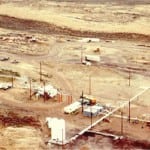A project piloting underground coal gasification (UCG) technology in Australia was last week shut down for tests by the Queensland Government for carcinogenic chemicals in nearby water bores.
The state Department of Environmental and Resource Management (DERM) on Friday shut down Cougar Energy’s Kingaroy UCG project, 300 km northwest of Brisbane, after the company detected in voluntary tests levels of benzene and toluene in groundwater monitoring bores close to the plant.
Cougar Energy later said it had received “incorrect laboratory results” associated with the tests. That claim was supported by the state agency, which said on Sunday that results from tests on samples of eight priority bore sites in and around the Kingaroy project site showed results of “trace levels of hydrocarbons 95% lower than the Australian Drinking Water Guidelines and do not represent risk to human health.”
On Tuesday, however, the Queensland government said that the order to shut down the plant would not be lifted until completion and review of the environmental evaluation by a UCG expert panel.
DERM also asked two other companies planning to test the technology, Linc Energy near Chinchilla, and Carbon Energy near Dalby, to look at their operations.
Before DERM’s order, Cougar Energy said it had begun final site preparation work, involving assembling and testing of pipework and electrical systems, air injection testing for the new wells, and preparation of the coal seam prior to ignition. The company forecasts that re-ignition of the gasification process will commence in the last week of this month.
UCG is a process by which coal is converted in situ into a combustible gas that can be used as a fuel or a chemical feedstock. According to Cougar Energy, UCG has the potential to exploit coal resources that are either uneconomic to work by conventional open cut or underground coal mining methods, or are inaccessible due to depth, geology, or other mining and safety considerations.
It basically involves drilling two adjacent boreholes into a coal seam more than 330 feet deep. An oxidant such as air or oxygen mixed with steam is then injected under pressure into one of the boreholes (the injection well) and is ignited at the coal seam, Cougar Energy says on its website. The hot combustion gases flow through the coal towards the second borehole, with the resulting chemical reactions converting the coal to a gas, which is then extracted through the second borehole (the production well). For more on the process, see “The Resurrection of Underground Coal Gasification,” in POWER’s January 2010 issue.
“With an appropriate UCG technology, the cost of the gas per unit of energy is much lower than natural gas,” the company claims. “When compared to current coal-fired power generation, these factors combine to provide a competitive cost of power at a smaller scale, with lower CO2 emissions, and longer term potential for CO2 removal and sequestration.”
But the incident could shut down the fledgling sector, suggests The Australian. Cougar Energy has lost public support for the project. The paper notes that there have been “many uninformed statements in regard to the Kingaroy project and possible health issues made in the public arena that are not attributed to the Queensland Government and/or Cougar Energy.”
Linc Energy, another Australian company that is operating a UCG demonstration plant, said in a statement “following inaccurate and misleading reports in local and national media over the weekend” that its UCG operations were different from those employed by Cougar Energy.
“Linc Energy notes that the groundwater monitoring data which it has collected at Chinchilla and supplied to DERM over the past 11 years evidences the fact that there has been no impact on the quality of the groundwater of adjacent property holders,” it said. “The investigation being undertaken by DERM in Kingaroy is specific to Cougar Energy and the manner in which it conducts its UCG operations with [UCG technology provider] Ergo Exergy.”
Sources: Cougar Energy, DERM, POWER, The Australian, Linc Energy









